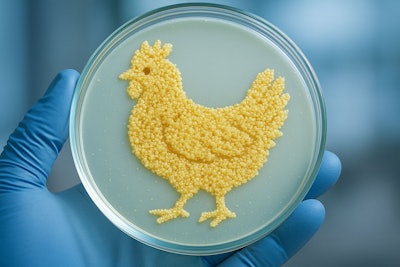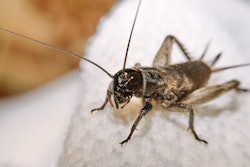
Creating meat without animals has been a dream of humanity for more than a century. However, getting the texture right and producing the cell-cultured meat at an affordable price has challenged scientists. For the pet food market though, the animal protein doesn’t need to look like a real chicken breast or steak. Scientists can create animal proteins using genetically modified yeasts. Researchers evaluated the protein from those yeast-chicken chimeras and observed that dogs could digest the cell-cultured protein with no negative effects on their health.
“It was highly digestible and there were some beneficial changes to the dogs’ gut microbes and metabolites,” Kelly Swanson, study co-author and professor at the University of Illinois at Urbana-Champaign. Bond Pet Foods funded the work. Doctoral student Meredith Smola led the study.
Yeast has long helped humans make beer, bread and other consumables. With genetic engineering, yeasts became providers of insulin and other medicines. To add animal protein to yeast’s repertoire, scientists inserted chicken DNA into the Saccharomyces cerevisiae (brewer’s yeast) genome. When those transgenic yeast proliferated, they produced poultry protein. Going back to their beer roots, the yeast were cultivated in large stainless-steel tanks similar to those used in breweries. Researchers extracted the protein and made dog food with it.
Healthy adult dogs are the cell-cultured chicken protein during a six-month feeding study. The dogs all started on a control diet. The dogs were then divided into four groups. Three were randomly assigned to eat a diet containing 15%, 30% or 40% brewed chicken protein. The fourth group remained on the control diet.
Not only did those dogs get their required amino acids, but the dogs had beneficial changes in their fecal metabolites and gut microbiota, with no allergic reactions or adverse changes in blood chemistry or other markers.
“These results indicate that the brewed chicken protein ingredient tested is an effective source of protein that is safe for use in adult dog foods at an inclusion level of up to 40%,” the researchers wrote in the journal Frontiers in Veterinary Science.
The cell-cultured chicken protein in the dogs’ diets decreased the digestibility of fats somewhat, although they remained highly digestible overall. The gut microbiota and microbiome metabolites also changed, but without negative effects.
Concentrations of the beneficial short-chain fatty acids butyrate, propionate and valerate rose in proportion to the amount of brewed chicken protein in the dogs’ food. Those amino acids are associated with reduced inflammation.
The amount of feces and fecal dry matter produced by the dogs eating cell-cultured chicken decreased in inverse proportion to the amount of brewed chicken protein in their diet. However, their feces were still soft, moist and of acceptable quality.
“When we were formulating these diets, we knew there was a lot of soluble fiber in them, and that was one thing I was a little nervous about — if it would cause loose stools or constipation, which is not a nice outcome for pets or their owners,” Swanson said. “And I was happy to see that the stool quality was not affected.”
Ecological and animal welfare benefits of cell-cultured meat
Along with dogs producing less of their own waste on the cell-cultured protein diets, lab-grown protein may be responsible for less waste than other amino acid sources. Cell-cultured meat production may offer environmental benefits for the pet food industry by reducing land use, water consumption and greenhouse gas emissions compared to conventional livestock agriculture. Traditional meat production relies on large-scale animal farming, which contributes to deforestation, methane emissions, pollution production and freshwater depletion. In contrast, cultivated meat is grown in controlled environments using animal cells, minimizing the need for pastureland and lowering the carbon intensity of production. This reduction in environmental impact is particularly relevant to the pet food sector, which utilizes large volumes of meat byproducts and often faces scrutiny over its contribution to the environmental footprint of the meat industry, whether truly deserved or not.
Incorporating cell-cultured meat into pet food formulations could also help companies meet growing sustainability goals and consumer demand for environmentally responsible products. With regulatory frameworks beginning to accommodate cell-cultured ingredients and new production technologies scaling, pet food manufacturers may find opportunities to diversify protein sourcing while promoting a lower-impact supply chain. Additionally, the controlled nature of cellular agriculture can improve supply consistency and resource efficiency, further aligning with corporate environmental, social and governance (ESG) strategies. As the technology matures, industry stakeholders are watching closely to evaluate its long-term viability and acceptance in pet food applications.
Considering that pet owners tend to be animal lovers in general, cell-cultured meat offers animal welfare advantages too, by eliminating the need to raise and slaughter animals. In the pet food industry, where meat ingredients are derived from livestock byproducts, the adoption of cultivated meat could support broader efforts to reduce reliance on animal agriculture. Because cell-cultured meat is developed from a small sample of animal cells, it allows for the production of substantial quantities of protein without repeated harm to animals. This approach aligns with growing consumer and industry interest in ethical sourcing and the reduction of animal suffering within the supply chain.
However, the development and scaling of cell-cultured meat technology involve considerable upfront costs and intensive resource use. Establishing bioreactors, nutrient media systems and clean manufacturing environments requires capital investment and technical expertise. Energy demands for maintaining sterile conditions and optimal cell growth environments may also be high, particularly in the early stages of commercialization. These factors present economic and operational hurdles that pet food producers must weigh against the ethical and long-term sustainability benefits.

















